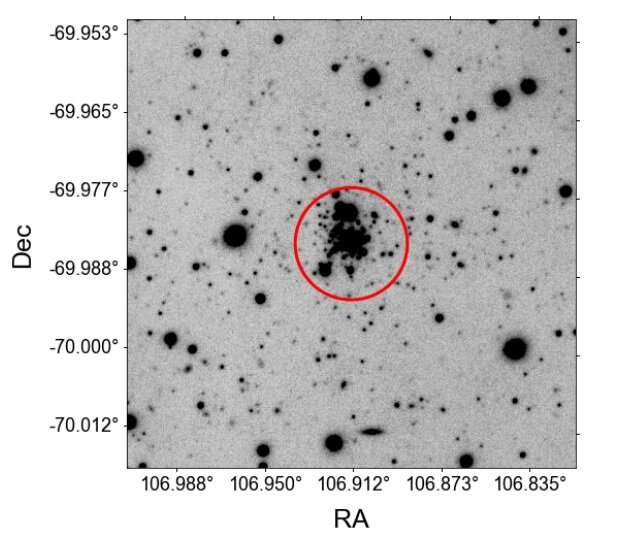July 28, 2022 report
Astronomers investigate star cluster KMHK 1762 in the Large Magellanic Cloud

Using the VLT Survey Telescope (VST), European astronomers have investigated a peculiar star cluster in the Large Magellanic Cloud (LMC), known as KMHK 1762. Results of the study were published July 19 on arXiv.org.
KMHK 1762 (also known as OHSC 37) is a star cluster in the LMC. The cluster has a metallicity at a level of -0.91 and its age is estimated to be about 2.7 billion years. However, an analysis of the color-magnitude diagram (CMD) of KMHK 1762 suggests that the cluster may be older than it is currently estimated.
A team of astronomers led by Massimiliano Gatto of the Capodimonte Astronomical Observatory in Naples, Italy, investigated this issue, assuming that KMHK 1762 may be a rare case of a star cluster in the so-called LMC age gap. Previous observations of LMC have found that this galaxy exhibits an almost total absence of star clusters with ages between 4 and 10 billion years. Within this age gap, only two confirmed star clusters have been identified so far.
Gatto's team have analyzed deep optical photometry of KMHK 1762 obtained with VST as part of the Yes, Magellanic Clouds Again (YMCA) survey. The study was complemented by data from ESA's Gaia satellite.
"In this letter, we report the result of our new study of KMHK 1762 SC [star cluster], based on the YMCA deep and accurate photometry, complemented with parallaxes and proper motions (PMs) from the Gaia Early Data Release 3 (EDR3)," the researchers wrote.
According to the new study, the proper age of KMHK 1762 should be greater than previously thought. Based on shallower photometry, the astronomers estimate that this cluster is about 5.5 billion years old. This means that KMHK 1762 is the third star cluster in the LMC age gap, besides clusters ESO121-03 and KMHK 1592.
The observations found that KMHK 1762 has a reddening of approximately 0.08 mag and its metallicity is at a level of -0.65. The CMD shows a clump of stars identified as main-sequence turn-off (MSTO) stars, a sub-giant branch (SGB), as well as a few stars in the red giant branch (RGB) and in the red clump (RC).
The finding made by the authors of the paper puts into question the existence of the star cluster age gap in LMC. They suggest that the increased number of confirmed or suspected clusters formed in the age gap period indicates that the age gap may be an observational bias, due to the combination of shallow photometry and limited investigation of the outer regions of LMC.
"In fact, most of the works devoted to the search of undiscovered star clusters focused in the LMC central regions leaving the outskirts (i.e. d > 4 kpc) quite unexplored and were conducted on the basis of photometrically shallow surveys, allowing the researchers to detect only star clusters younger than ∼ 1–1.5 Gyrs," the researchers concluded.
More information: M. Gatto et al, KMHK 1762: Another star cluster in the Large Magellanic Cloud age gap. arXiv:2207.09478v1 [astro-ph.GA], arxiv.org/abs/2207.09478
© 2022 Science X Network




















